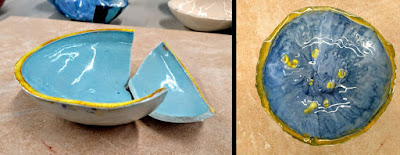It struck me that what might be the largest difference between the AKI and the UT, is not the environment, the tools, the ideas, or even the building, but it is the people. How could it be anything else, I realized, that makes the difference so great. People are what gives a location an atmosphere, what gives a place a hart.
The people at the AKI are open-minded, curious, strange even. They do not fret to be different, one might even say that they are afraid not to stand out. They are creative, push themselves to new projects and activities. I respect how they can continue to be creative -after one day at the AKI, I am creatively satisfied for a week-, and how they are capable of pushing the limits of materials and techniques, finding a way to tailor it to their needs, and how they can trigger ideas without using any words, just by using a combination of (predominantly) visual triggers.
The people at the UT are structured, thought-through, and calm. They want to follow their interest, sometimes even passion, in a specific field. They hope to bring the knowledge of the world one step further by adding their structure and research. This way they contribute a -what to others can seem minuscule or irrelevant- bit of knowledge in a very specific field of knowledge, slowly digging up all that there is to know about the world. Slowly improving our life and health in the process.
Both want to change the world, but in very different ways. where one aims to open ones eyes to the world, or merely contribute to the aesthetics, the other has the goal to improve the world by revealing new knowledge.
Being at the AKI once a week was as a refreshing dive into a different world view. Where different ideas and ideals hold. I was surprised by the openness and curiosity of the people. I have been asked many times what I was doing, who I was, why I did what I did. This slowly gave me the confidence to talk about my work, my ideas, and eventually, about myself. By making something that people show interest in, you yourself also feel more interesting as a person. You are the person that triggered curiosity through your work.
It was a disappointing realization. When I was in the lab that I worked, the birthplace of my work, to take pictures of what I made, I noticed how little people were interested in what I had in my four cardboard boxes. I was ignored. This shocked me. Had I romanticized the curiosity of people? had I become too arrogant? Too assured of the attraction of my work? As I started taking pictures around the lab, I got some strange looks, and slowly questions started to come. But after a one-minute pitch of what it was that I was doing, interest declined and my conversation partner would return to his/her work. I think this was because what I did, did not contribute to what they thought was important in life. Why would you make art, when you can improve the world through knowledge? They might have a point, but I think this view gives art too little credit in its ability to change the world.
Both types of people have their own advantages, giving me two different ways to regard the world. I am in the unique opportunity to cherry pick from both. I can look at the world with bright, curious, yet structured eyes. I know how to express myself as an artist(-ish) -I noted I even started to dress differently over the past half year-, but also I can fit in, in the world of structure and research. In the end I am partially both, I am both people, and in my head both have a voice that narrates my life. I try to listen, hoping neither will fall silent.




















































